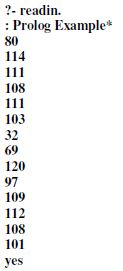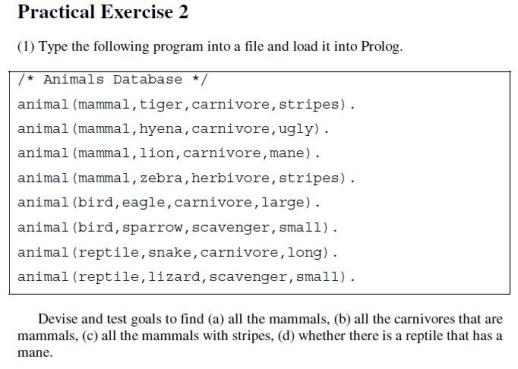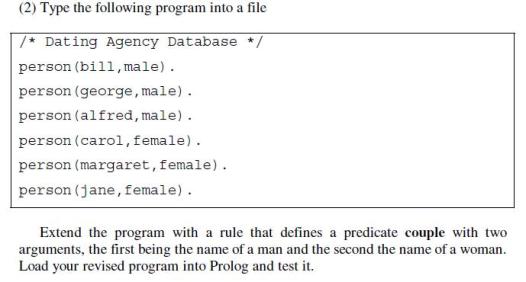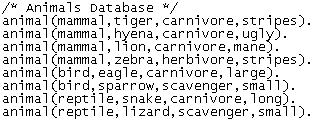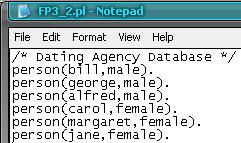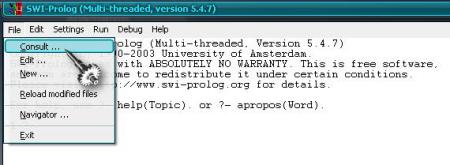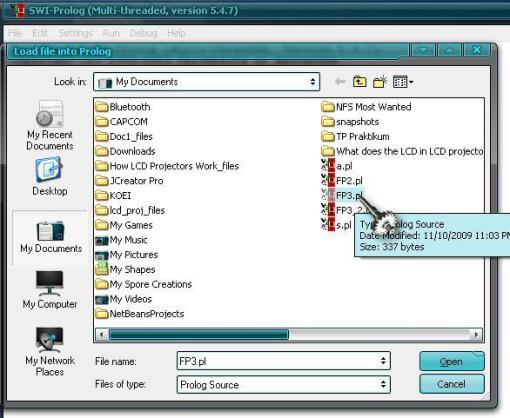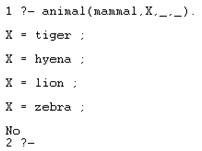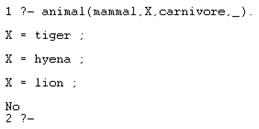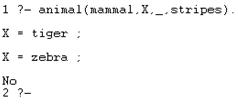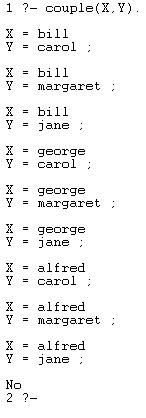Input dan Output
built-in predikat yang membaca dari dan menulis baik untuk pengguna
terminal (keyboard dan layar) atau file, kedua istilah tersebut dengan istilah dan characterby -
karakter dalam program Anda sendiri. nilai ASCII untuk memanipulasi string karakter. Menggunakan istilah lebih sederhana dan akan dijelaskan terlebih dahulu. Awalnya, maka akan diasumsikan bahwa
semua output ke layar pengguna dan semua input adalah dari pengguna keyboard. Masukan dan keluaran menggunakan file eksternal.
Syarat keluaran
predikat mengambil satu argumen, yang harus yang valid Prolog istilah. Mengevaluasi menyebabkan predikat istilah yang akan ditulis ke arus keluaran
sungai, yang secara default adalah layar pengguna. (Yang dimaksud dengan arus keluaran Dengan Logika Pemrograman Prolog
streaming)
Contoh
? - Menulis (26), nl.
26
ya
? - Menulis ( 'string karakter'), nl.
string karakter
ya
? - Menulis ([a, b, c, d, [x, y, z]]), nl.
[a, b, c, d, [x, y, z]]
ya
? - Tulis (mypred (a, b, c)), nl.
mypred (a, b, c)
ya
? - Write ( 'Contoh penggunaan nl'), nl, nl, write ( 'akhir contoh'), nl.
Contoh penggunaan nl
contoh akhir
ya
Syarat memasukkan
Built-in predikat membaca disediakan untuk memasukkan istilah. Dibutuhkan satu argumen, yang harus menjadi variabel.
Mengevaluasi itu menyebabkan istilah berikutnya untuk dibaca dari input arus sungai,
yang secara default adalah pengguna keyboard. (Yang dimaksud dengan arus input). Dalam input stream, istilah harus diikuti oleh sebuah titik ('.') dan setidaknya satu spasi, seperti spasi atau baris baru. Titik dan spasi karakter dibaca dalam tetapi tidak dianggap bagian dari istilah. Perhatikan bahwa untuk masukan dari keyboard (hanya) sebuah prompt karakter seperti titik dua biasanya akan ditampilkan untuk menunjukkan bahwa input pengguna diperlukan. Mungkin perlu untuk tekan tombol 'kembali' tombol sebelum Prolog akan menerima input. Kedua tidak berlaku untuk masukan dari file. Ketika sebuah tujuan membaca dievaluasi, istilah input disatukan dengan argumen variabel. Jika variabel tidak terikat (yang biasanya terjadi) itu adalah terikat pada masukan nilai.
Contoh
? - Read (X).
: Jim.
X = jim
? - Read (X).
: 26.
X = 26
? - Read (X).
: Mypred (a, b, c).
X = mypred (a, b, c)
? - Read (Z).
: [A, b, mypred (p, q, r), [z, y, x]].
Z = [a, b, mypred (p, q, r), [z, y, x]]
? - Read (Y).
: 'String karakter'.
Y = 'string karakter'
Input dan Output Menggunakan Karakter
Meskipun input dan output dari syarat-syarat sangat mudah, penggunaan tanda kutip dan penuh berhenti dapat menjadi rumit dan tidak selalu sesuai. Sebagai contoh, akan membosankan untuk menentukan predikat (menggunakan baca) yang akan membaca serangkaian karakter dari keyboard dan menghitung jumlah huruf vokal. Sebuah pendekatan yang lebih baik untuk masalah semacam ini adalah untuk masukan sebuah karakter pada satu waktu. Untuk melakukan hal ini, pertama-tama perlu
untuk mengetahui tentang nilai ASCII karakter. Semua mencetak karakter dan banyak karakter non-cetak (seperti ruang dan tab) memiliki sesuai ASCII (American Standard Kode untuk Informasi Interchange) nilai, yang merupakan integer 0-255. Nilai ASCII karakter yang kurang dari atau sama dengan 32 yang dikenal sebagai putih ruang karakter.
Keluaran karakter
Karakter adalah output dengan menggunakan built-in predikat meletakkan predikat mengambil argumen tunggal, yang harus menjadi nomor 0-255 atau ekspresi yang
mengevaluasi ke integer dalam jangkauan. Mengevaluasi tujuan put menyebabkan satu karakter untuk menjadi output untuk saat ini output stream. Ini adalah karakter yang sesuai dengan nilai numerik (ASCII nilai) dari argumen.
misalnya
? - Meletakkan (97), nl.
sebuah
ya
? - Meletakkan (122), nl.
z
ya
? - Meletakkan (64), nl.
@
ya
Output ke sebuah File
Meskipun definisi di atas kirim menyatakan bahwa 'semua file yang sudah ada dengan yang sama Namanya dihapus ', ada kemungkinan lain, yang penting bagi beberapa aplikasi, yaitu bahwa file tersebut tidak dihapus dan setiap output ditempatkan setelah akhir isi yang ada file. Baik 'menimpa' dan 'append' pilihan
kemungkinan besar akan tersedia dalam pelaksanaan praktis Prolog tetapi mungkin melibatkan menggunakan predikat yang berbeda (misalnya terbuka) sebagai pengganti atau serta kirim.
Input: Mengubah Input Current Stream
Input stream yang aktif dapat diubah dengan menggunakan melihat / 1 predikat. Ini membutuhkan argumen tunggal, yang merupakan atom atau variabel yang mewakili nama file, misalnya lihat ( 'myfile.txt'). Mengevaluasi sebuah tujuan melihat menyebabkan file bernama input yang menjadi sungai. Jika file ini belum terbuka itu pertama kali dibuka (untuk akses baca saja). Jika tidak mungkin untuk membuka file dengan nama yang diberikan, kesalahan akan dihasilkan.







